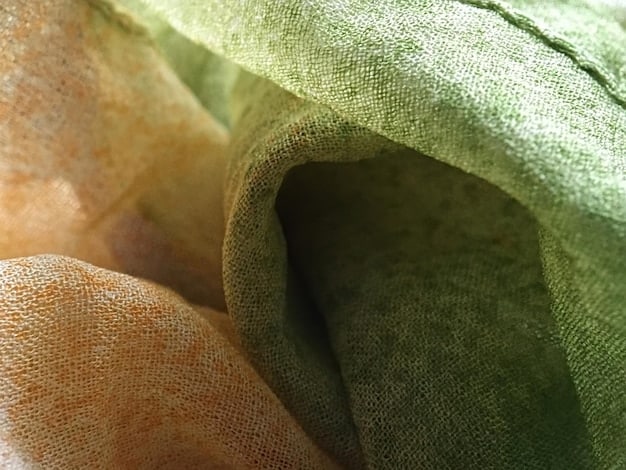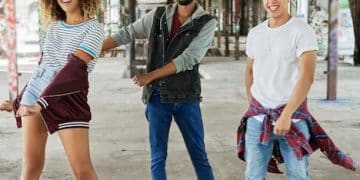Sustainable Style: Eco-Friendly Fabrics Reshaping US Fashion

Sustainable style is revolutionizing the US fashion industry as eco-friendly fabrics gain prominence, driven by increased consumer awareness and innovative textile technologies that are paving the way for greener, more stylish choices.
The fashion industry in the United States is undergoing a significant transformation. As consumers become more environmentally conscious, the demand for sustainable clothing is on the rise. This shift is largely driven by the innovative eco-friendly fabrics that are redefining what it means to be fashionable.
But how exactly are these fabrics changing the game? Let’s explore how sustainable style: how eco-friendly fabrics are redefining US fashion trends, influencing designers, and empowering consumers to make eco-conscious choices.
Understanding Sustainable Style: How Eco-Friendly Fabrics Are Redefining US Fashion Trends
The concept of sustainable style is no longer a niche trend but a growing movement. It encompasses the entire lifecycle of a garment, from sourcing materials to production methods and eventual disposal. Eco-friendly fabrics play a crucial role in minimizing the environmental impact of the fashion industry, offering alternatives to conventional materials that are often resource-intensive and polluting.
The Environmental Impact of Traditional Fabrics
Traditional fabrics like cotton and polyester have significant environmental footprints. Cotton production requires vast amounts of water and pesticides, while polyester is derived from petroleum, a non-renewable resource. The dyeing and finishing processes also contribute to water pollution and greenhouse gas emissions.
Emergence of Eco-Friendly Alternatives
As awareness of these issues grows, innovative companies are developing eco-friendly alternatives. These fabrics include:
- Organic Cotton: Grown without synthetic pesticides or fertilizers, reducing harm to ecosystems and human health.
- Recycled Polyester: Made from recycled plastic bottles or other plastic waste, diverting waste from landfills and reducing the need for virgin polyester.
- Hemp: A fast-growing, low-input crop that requires little water and no pesticides.
- Lyocell (Tencel): Made from sustainably harvested wood pulp using a closed-loop production process that minimizes waste and water usage.

These alternatives not only reduce environmental impact but also offer unique qualities that can enhance the look and feel of clothing. Sustainable fabrics are becoming increasingly popular in sustainable style.
The Rise of Eco-Conscious Consumers in the US
Consumer demand is a powerful driver of change in the fashion industry. More and more consumers in the US are seeking out sustainable options, voting with their wallets for brands that prioritize ethical and environmental responsibility.
Increased Awareness and Education
The internet and social media have played a significant role in raising awareness about the environmental and social impacts of fast fashion. Consumers are now more informed and discerning, seeking out information about the origins and production of their clothing.
Demand for Transparency
Consumers are also demanding greater transparency from brands. They want to know where their clothes are made, who made them, and what materials were used. Brands that provide this information are more likely to earn the trust and loyalty of eco-conscious consumers who want to embrace sustainable style.
Shifting Values and Priorities
As younger generations enter the workforce and gain purchasing power, their values are shaping market trends. Millennials and Gen Z are more likely to prioritize sustainability and ethical considerations when making purchasing decisions. This is propelling the demand for eco-friendly fashion forward.
The rise of eco-conscious consumers is forcing brands to re-evaluate their practices and invest in sustainable materials. The increasing prominence of sustainable style: how eco-friendly fabrics are redefining US fashion trends in the US market can not be ignored.
How Eco-Friendly Fabrics are Redefining US Fashion Trends
Eco-friendly fabrics are not just about sustainability; they’re also influencing the aesthetics and functionality of clothing. Designers are embracing these materials to create innovative and stylish designs without compromising environmental values. They can be used in a variety of items, promoting sustainable style.
Innovation in Textile Technology
Advances in textile technology have made it possible to create high-performance eco-friendly fabrics that rival traditional materials in terms of durability, comfort, and aesthetics. This is helping to overcome the perception that sustainable clothing is somehow inferior or less stylish.
Versatility in Design
Eco-friendly fabrics are incredibly versatile and can be used to create a wide range of garments, from casual wear to high-fashion pieces. Designers are experimenting with different textures, colors, and blends to showcase the unique qualities of these materials.
Examples of Eco-Friendly Fashion Trends
Here are some examples of how eco-friendly fabrics are shaping current fashion trends:
- Upcycled Clothing: Garments made from repurposed or recycled materials, often featuring unique and eclectic designs.
- Minimalist Wardrobes: Capsule wardrobes consisting of high-quality, timeless pieces made from sustainable fabrics.
- Ethical Athleisure: Activewear made from recycled polyester or organic cotton, promoting both performance and sustainability.

This shows that sustainable style: how eco-friendly fabrics are redefining US fashion trends also impacts how things are designed.
Brands Leading the Way in Sustainable Fashion
Several brands in the US are at the forefront of the sustainable fashion movement, demonstrating that it is possible to create stylish, high-quality clothing while minimizing environmental impact.
Patagonia
Patagonia has long been a pioneer in sustainable fashion, using recycled materials and advocating for responsible manufacturing practices. The brand’s commitment to environmental activism has earned it a loyal following among eco-conscious consumers.
Eileen Fisher
Eileen Fisher is known for its timeless designs and commitment to sustainability. The brand uses organic cotton, recycled materials, and eco-friendly dyes, and also offers a Renew program that allows customers to recycle their old Eileen Fisher garments.
Reformation
Reformation is a popular brand that combines stylish designs with sustainable practices. The brand uses eco-friendly fabrics, such as Tencel and recycled cotton, and also provides detailed information about its environmental impact.
The Role of Certifications
Certifications like GOTS (Global Organic Textile Standard) and OEKO-TEX Standard 100 provide assurance that fabrics meet certain environmental and social standards. Brands that use certified fabrics can offer consumers greater confidence in their sustainability claims. These brands are heavily promoting sustainable style in their products.
These brands are paving the way for a more sustainable fashion industry, demonstrating that it is possible to create beautiful, high-quality clothing while minimizing environmental impact. As consumers continue to demand sustainable options, more brands are likely to follow suit, further cementing sustainable style: how eco-friendly fabrics are redefining US fashion trends.
Challenges and Opportunities in the Sustainable Fabric Market
While the sustainable fabric market is growing rapidly, there are still challenges to overcome. Addressing these challenges will be essential for accelerating the transition to a more sustainable fashion industry. But there are also opportunities to create a sustainable style market.
Cost and Availability
Eco-friendly fabrics are often more expensive than traditional materials, which can be a barrier for some brands and consumers. However, as demand increases and production scales up, the cost of these fabrics is likely to decrease.
Supply Chain Transparency
Ensuring transparency throughout the supply chain is crucial for verifying the sustainability claims of fabrics. Brands need to work closely with their suppliers to ensure that materials are sourced and produced responsibly.
Consumer Education
Many consumers are still unaware of the benefits of eco-friendly fabrics and the environmental impact of traditional materials. Educating consumers about these issues is essential for driving demand for sustainable fashion.
Opportunities for Innovation
The sustainable fabric market is ripe with opportunities for innovation. New technologies and materials are constantly being developed, offering exciting possibilities for creating more sustainable and stylish clothing. This ensures sustainable style: how eco-friendly fabrics are redefining US fashion trends can continue for a long time.
| Key Point | Brief Description |
|---|---|
| ♻️ Eco-Friendly Fabrics | Alternatives like organic cotton and recycled polyester reduce environmental impact. |
| 🛍️ Consumer Demand | Growing awareness drives demand for sustainable options. |
| 👗 Fashion Trends | Eco-fabrics influence aesthetics and functionality in clothing design. |
| 🌱 Brand Leadership | Brands like Patagonia & Eileen Fisher lead with sustainable practices. |
FAQ
Eco-friendly fabrics reduce environmental impact by using fewer resources and reducing pollution. They also promote ethical labor practices and are often safer for consumers’ skin.
Look for certifications like GOTS or OEKO-TEX, check brand transparency about materials and production, and consider buying from brands known for their sustainability efforts.
No, many affordable and mainstream brands are beginning to incorporate eco-friendly fabrics and sustainable practices. Options are becoming more accessible over time.
Common options include organic cotton, recycled polyester, hemp, linen, and Tencel (lyocell), each offering unique benefits in terms of sustainability and performance.
Sustainable fabrics can inspire innovative designs and often offer comparable or superior quality. Advances in textile technology ensure durability, comfort, and aesthetic appeal.
Conclusion
As we have explored, the rise of sustainable style: how eco-friendly fabrics are redefining US fashion trends is undeniable. Driven by eco-conscious consumers and innovative brands, the US fashion industry is embracing materials and methods that minimize environmental impact.
By choosing sustainable options, consumers can contribute to a more ethical and environmentally responsible fashion industry. It is a trend that promises a greener, more stylish future for all.





